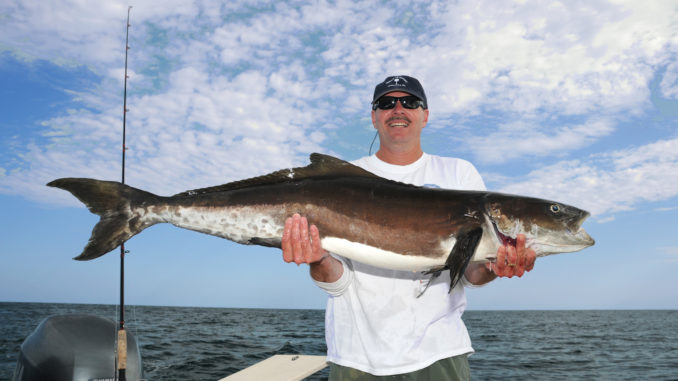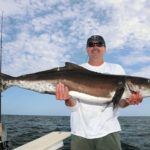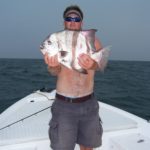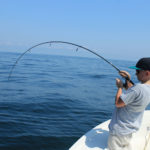
Georgetown is jumping-off spot for great Cape Romain Reef action.
The wind was up, and the rocking of the boat made it difficult to stand as it pounded its way around Cape Romain Reef in late May while we tried our hand at a “reef double.”
May and early June can be prime time to fish around the artificial reef that, like many others, was established by the S.C. Department of Natural Resources to produce suitable habitat for nearshore species.
Many different species call the Cape Romain Reef home, but the windy day trip was for just two of them, the reef double of spadefish and cobia, two of the pound-for-pound hardest-fighting fish in the ocean. While the spadefish is more along the lines of a saltwater panfish, the cobia is a beast.
As the temperature begins to warm around Georgetown and McClellanville, anglers familiar with the area begin to head to the reefs for some reel-screaming action. While many other species get more attention, few match the fighting power and strength of the spadefish, which will stretch the stamina of many anglers.
Robert McCarley of Reel Tight Fishing Charters often targets these two species in particular.
“On many occasion, the spades are so thick, my clients just simply get tired of catching them,” McCarley said.
Pull after pull, reel after reel is stretched to its limits as these hearty fish make long runs in an effort to get away. McCarley prefers spinning reels on the light side for spadefish — long, flexible rods in the 7-foot range to help wear the fish out, coupled with a large-capacity reel like the Penn Battle holding 20-pound braid tipped with a 20-pound fluorocarbon leader.
“Fluorocarbon,” McCarley said, “is a must for spades; the water is so clear, they just won’t bite as well if you use anything else.”
Bar none, the best bait for spadefish are cannonball jellyfish, stomolophus meleagris, locally known as “jelly balls.” A common method of attracting spades is to gather a couple dozen jelly balls and connect a half-dozen or so on either a long rope or, McCarley’s preferred method, an extra rod and reel.
“This way, I can maneuver them through the water column easier and faster. Once fish are located on the graph, lower the string of jelly balls into the crystal-clear water, and the spadefish will start to feed on (them),” he said. “Slowly begin to raise the string of jelly balls, moving the fish closer to the surface, until (they) are in sight.”
McCarley said one of the hardest part is being patient when they bite.
“It’s hard for people to let them run with the bait, but their mouth is small, and it often takes them a while to get the hook into their mouths.” said McCarley, who prefers a 2/0 J hook tipped with a piece of the jelly ball. Lower this right beside the chum line and hold on.
“One of the best part of spade-fishing is watching the fish take your bait” McCarley said. “Anglers love seeing when their bait gets eaten.”
After the bait is eaten, McCarley will often open the bail and let the fish run for a few yards before engaging the reel and setting the hook.
“It usually takes them a while to get the hook in their mouths,” he said.
Another great thing to remember, McCarley said, is that spadefish are intense schooling fish.
“A fighting fish will often attract other fish, so before you land your fish, get the other anglers to cast near the one you have hooked and often you will pick up additional fish,” he said.
Spadefish are nearly as wide as they are long, with four to six vertical black bars along each side. These bars usually fade as the fish grow but can still be seen. The average size of a spade is 16 to 18 inches and 6 to 8 pounds, with the state record coming in 2009 at 14 pounds, 2 ounces, so a 10-pound spadefish is a real trophy.
Spadefish, a member of the grouper-snapper complex, are managed with a daily creel limit of 20 fish in aggregate with other similar species. While spades can be caught in estuaries, the mouths of bays and even over oyster beds, they congregate around the artificial reefs that dot our shoreline.
Many of these artificial reefs are within sight of land and are accessible to relatively small boats under ideal conditions. As May rolls into June, spades will move from the deeper reefs farther offshore and stack up around reefs in 30 to 65 feet of water. That’s one reason Cape Romain Reef is so special: It sits in 65 feet of water — the optimum depth for attracting and holding large schools of spadefish.
Located about 12 nautical miles south-southeast of Winyah Bay, the reef is easily accessible. Three other reefs in the area are within a 10-minute boat ride of Cape Romain Reef — the Hector Reef, Greenville Reef and Davidson Reef — if fish there aren’t being cooperative.
Once you arrive at the reef, start puttering around, watching your electronics for signs of fish. Once a cluster of fish is located, drop anchor and start fishing.
“If when I get here I can see spades feeding, I will move upwind and simply drift through them, casting chunks of jelly balls or fresh whole shrimp,” McCarley said. “If I don’t see anything feeding, I’ll graph around for a few minutes and drop the line of jelly balls into the water. If the fish are there, we will know shortly.”
Cobia, the second half of the “reef double,” will often hang out around nearshore reefs after they have been inshore to spawn. May and June are prime months.
Suddenly catching sight of a cobia circling the reef will change a fisherman’s mind about spadefish. Catching a cobia on light spadefish gear isn’t impossible, but in the old vernacular, “It ain’t likely.”
McCarley keeps an outfit ready to sight-cast to any cobia he sees: a 6-foot Ugly Stik mated with a Penn Battle reel filled with 80-pound braid and an 80-pound mono leader.
“I use the same rig for cobia that I use for tarpon, shark and other big fish,” he said. “They are so strong, you need the heavy gear to land them.”
McCarley’s fishing party on the windy day saw the brown, torpedo shape of a cobia circling the reef, and the guide coached his fishermen through the process.
“Toss this right in front of him and let it sink; as soon as it hits the water, get ready,” he said, handing an outfit tipped with a 2-ounce bucktail with a hook McCarley had filed to a keen age.
“Cobia have very tough mouths, so if the hook isn’t sharp, it’s likely he will spit the bait,” said McCarley, whose first few coaching efforts produced nothing but an ‘I’m not interested’ look from the cobia.
Persistence paid off, however, as the next try proved to be the charm. As the bait hit the water, the 40-inch cobia swirled and ate it faster than the reel could be engaged, pulling line out as breakneck speed. When the reel was finally engaged, the sharpened hook did its job, sinking deep into its mouth, and the fight was on.
It took 15 minutes to bring the cobia to the side of the boat.
“That is why I come to these reefs in May and June,” McCarley said. “The spadefish are thick, and the cobia are moving back out into this deeper water. It’s the perfect time to double up on two of the hardest fighting fish in the ocean.”
Cobia are very curious fish, and this can be their most frustrating part of sight-fishing for them. They will come and investigate almost everything that is tossed in their direction, but they can be finicky when it comes to a bite.
“If I toss the bucktail four or five times and he doesn’t bite, I change quickly to some live bait,” he said. “Often, a lively menhaden or mullet will push them over the edge, but if I can’t get fresh bait, I have caught a lot of cobia on dead menhaden and mullet.”
The tendency is for the angler to give up long before the fish gives up. Try a jig or bucktail first, or toss a 6-inch mullet in front of them.
“You just don’t know what they are going to eat that day, so I try and be ready,” McCarley said.
Cobia are long fish, much longer than they are wide, and they carry a dark brown coloration with two silver bands along each side. Fish in excess of 40 pounds are landed every year in these waters, but McCarley said his average May-June cobia is in the 30-pound range. The state-record fish, caught in 2009, weighed 92-10. A daily creel limit of two fish with a 33-inch size minimum (fork length measurement) is about as much as many fishermen can stand.
For anglers looking to test their skill and gear, the spadefish/cobia combination is accessible, challenging and a real test of angler and equipment. A trip to Cape Romain is truly complete when the double is accomplished.
DESTINATION INFORMATION
HOW TO GET THERE — Cape Romain Reef is 12 miles of the Winyah Bay channel buoy, almost directly south (32.59.858N/79.02.332W). It can be most easily reached from various ramps in the Georgetown area, but also from the private McClellanville municipal ramp, and from the Francis Marion National Forest’s Buck Hall Ramp on the ICW near Awendaw. Other nearby reefs are the Hector (32.59.977N/79.06.075W), the Greenville (32.56.818N/78.54.643W) and the C.J. Davidson (33. 05.953N/79.00.759W).
WHEN TO GO — Cobia arrive around the Cape Romain Reef in late May and June after spawning inshore. Spadefish arrive from offshore about the same time and will stay through the summer.
TACKLE/TECHNIQUES — Light to medium-light spinning tackle is the ticket for spadefish; slivers of cannonball jellyfish are the best baits, but shrimp pieces will also work. For cobia, heavy tackle is the rule, with bucktails or live menhaden and mullet. Fluorocarbon leaders are required for both sharp-eyed species.
FISHING INFO/GUIDES — Robert McCarley, Reel Tight Fishing, 843-458-4157 or www.reeltightfishing.com. See also Guides and Charters in Classifieds.
ACCOMMODATIONS — Georgetown County Tourism Management Commission, 843-546-8436 or www.hammockcoast.com.
MAPS — Capt. Segull’s Nautical Charts, 888-473-4855, www.captainsegullcharts.com; Sealake Fishing; Guides, 800-411-0185, www.thegoodspots.com; Maps Unique, 910-458-9923, www.mapsunique.com.








Be the first to comment